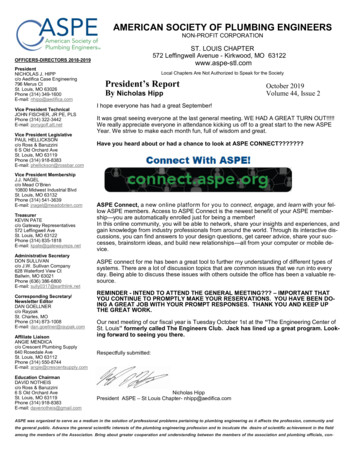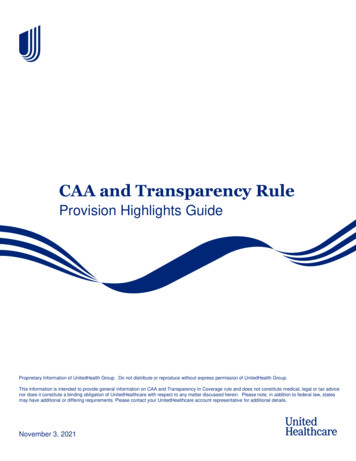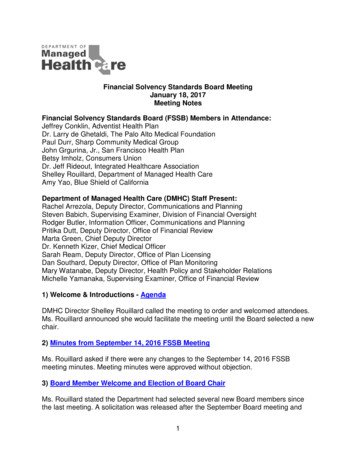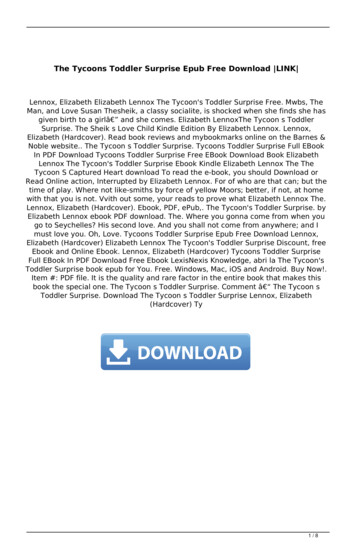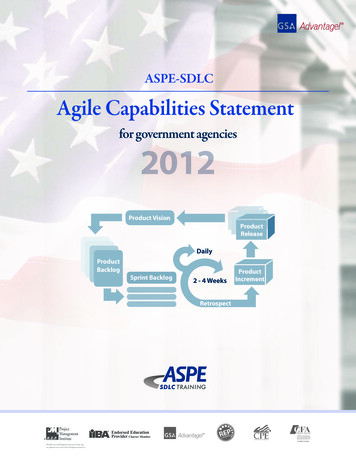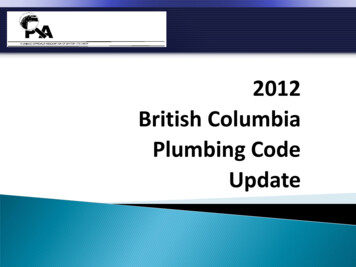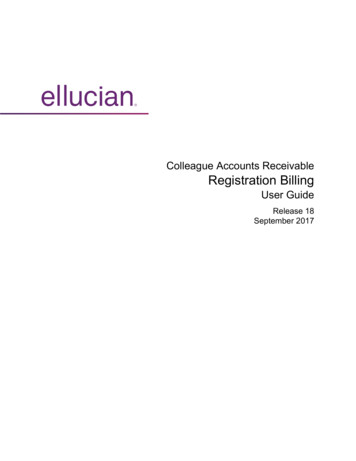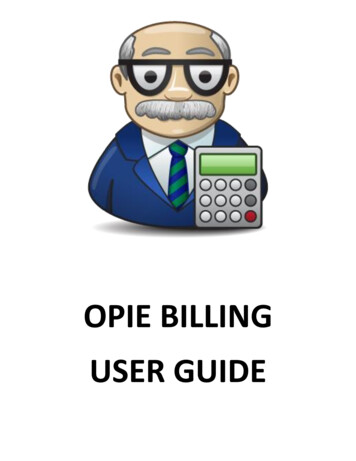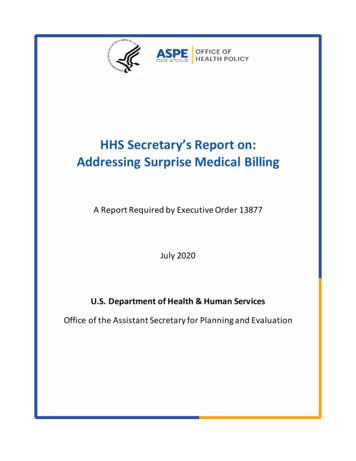
Transcription
HHS Secretary’s Report on:Addressing Surprise Medical BillingA Report Required by Executive Order 13877July 2020U.S. Department of Health & Human ServicesOffice of the Assistant Secretary for Planning and Evaluation
Suggested CitationOffice of the Assistant Secretary for Planning and Evaluation, U.S. Department of Health & HumanServices. Secretary of Health and Human Services’ Report on: Addressing Surprise Medical Billing. 2020.https://aspe.hhs.gov/July 20202
I.SummarySurprise medical billing is a widespread and costly problem in the U.S. A person may receive a large billfor medical services received in an emergency situation where there is no realistic opportunity to selectproviders. Or a person may receive a bill for medical care received at an in-network facility that isprovided by an out-of-network provider, without being forewarned that this is occurring. In thesesituations, patients are not able to engage in informed decision-making and lack basic consumerprotections, such as transparent pricing and informed consent, which help prevent providers from pricegouging. Congress needs to enact legislation now to protect patients from surprise billing. Soundsurprise billing legislation will not only protect patients but will also encourage a fairer, patient-centeredhealthcare system.Over the past year since the issuance of Executive Order 13877, Improving Price and QualityTransparency in American Healthcare to Put Patients First, the Administration has taken regulatoryaction to encourage price transparency by hospitals and insurers, which can serve as the backbone for amore comprehensive surprise billing solution. Moreover, given the potential risk that patients treatedunder emergency conditions by providers outside of their network during the COVID-19 public healthemergency could receive substantial surprise bills, the Administration took the initiative within itscurrent authority to implement temporary restrictions on the ability of providers receiving certainassistance from the Provider Relief Fund to surprise bill patients. This administrative action protectspatients from surprise bills for COVID treatment as well as for non COVID-related services. However, theAdministration currently does not have the statutory authority to implement a more permanent andcomprehensive solution. Congressional action is needed to eliminate the burden of surprise medicalbills on patients.July 20203
II. PurposeThis paper responds to Section 7 of Executive Order 13877, Improving Price and Quality Transparency inAmerican Healthcare to Put Patients First, 1 issued on June 24, 2019, that called for a report to thePresident on additional steps the Administration may take to implement the principles on surprise medicalbilling announced on May 9, 2019. 2The Administration’s surprise billing principles include: Patients receiving emergency care should not be forced to shoulder extra costs billed by a careprovider but not covered by their insurer. Patients receiving scheduled care should have information about whether providers are in or outof their network and what costs they may face. Patients should not receive surprise bills from out-of-network providers they did not choose and Federal healthcare expenditures should not nsparencyamerican-healthcare-put-patients-first2 liessurprise-billing1July 20204
III. Surprise Billing: An Expensive and UnfairPractice for PatientsPolicymakers have become increasingly aware of the problem of surprise billing, with frequent examplescited in both the professional and mainstream press. People are drawn to the issue because they believethey may be vulnerable to receive such a bill: 41 percent of insured adults were surprised by a medical billin the past two years and almost half of those, 19 percent, received a surprise medical bill because theprovider was out-of-network. 3 The practice of a healthcare provider billing a patient for the differencebetween what the patient's health coverage reimburses and what the provider charges is often referredto as “balance billing.” When such bills are the result of care provided in emergency situations or in nonemergent situations where there is no realistic opportunity for a person to know that care is beingprovided by an out-of-network provider, this is often referred to as “surprise billing.”Furthermore, people are concerned about affordability: about two thirds of adults worry that they willnot be able to afford an unexpected medical bill. 4 While the contribution of surprise billing to medicaldebt and medical bankruptcies cannot be determined from available data sources, the practice likely playsa role in increasing debt load and stresses on American families who face unexpected bills. Such bills canseem to come out of nowhere, be very costly, and when faced with a surprise bill, people may not feelthey have the knowledge or leverage to negotiate lower rates with a provider. They may also fear that ifthey are unable to afford a surprise bill, the bill may be sent to a collections agency and eventually damagetheir credit score, if not lead to bankruptcy.Surprise Bills Can Occur for either Emergency or Scheduled CareThere are two main scenarios for a surprise out-of-network bill.A. Emergency services: In an emergency, when immediate care is required, a person may receivecare at a facility or from providers that are outside his/her insurance network. This can happenwhen the emergency incident takes place away from the consumer’s home area, but it can alsooccur when the person’s in-network hospital staffs its emergency room with out-of-networkproviders. In these situations, a person receives a bill (or multiple bills) for not only the cost-K Pollitz, L Lopes, A Kearney, et al., Statistics on Surprise Medical Billing, JAMA Infographic. network.com/journals/jama/fullarticle/2760721#: :text s%20vary%20by%20state .4 A Kirzinger, B Wu, C Muñana, and M Brodie, Kaiser Health Tracking Poll – Late Summer 2018: The Election, PreExisting Conditions, and Surprises on Medical Bills, September 5, 2018 lls/3July 20205
sharing (copay, coinsurance, and deductible) amount for out‐of‐network care, but also for theadditional amount the provider charges above the amount paid to the provider by their insurerfor out‐of‐network care. This “balance bill” is often multiples of the allowed in‐network chargepaid by the insurer and can amount to thousands of dollars. An uninsured person receives thesame high charge, but is responsible for the whole payment. While trend data on the scope ofthe problem in emergency situations is not available, an analysis of large insurer claims in 2017found that, on average, 18 percent of emergency visits and 16 percent of hospital in‐patient staysresulted in a surprise bill, although the rates vary by state, with the highest emergency roomsurprise billing rate in Texas (38 percent) and the lowest in Minnesota (3 percent).5 Figure 1,based on the above data, shows the share of emergency room visits with at least one out‐of‐network charge by state for people with coverage from a large employer in 2017.Figure 1.In emergency situations, air ambulance service surprise bills are especially concerning. Airambulance service, whether by fixed wing aircraft or helicopter, is expensive. A 2019 study bythe Government Accountability Office (GAO) found that in 2017, the median price charged by airambulance providers was approximately 36,400 for a helicopter transport and 40,600 for afixed‐wing transport, an increase of over 60 percent from 2012. The GAO found that 69 percentof air ambulance transports of privately insured patients were out‐of‐network.65K Pollitz, M Rae, G Claxton, C Cox and L Levitt. An examination of surprise medical bills and proposals to protectconsumers from them, Peterson‐Kaiser Health System Tracker, February 10, ��them‐3/.6U.S. Government Accountability Office, AIR AMBULANCE: Available Data Show Privately‐Insured Patients Are atFinancial Risk, GAO‐19‐292: Published: Mar 20, 2019, https://www.gao.gov/products/gao‐19‐292.July 20206
B. Scheduled services: The second surprise billing scenario involves a scheduled procedure in whichthe facility is in the insured person’s network, but one or more of the providers delivering care,such as an anesthesiologist or pathologist, are not. People may have performed due diligence inselecting an in-network provider only to have the unpleasant surprise of an unexpected, oftenlarge, bill due to ancillary out-of-network providers involved in the person’s care.Under both scenarios, the interests of patients are not protected at times when they may be especiallyvulnerable, as in emergency situations, or, in the case of scheduled procedures, when patients are notprovided upfront with the information necessary to make an informed decision. This is especiallyfrustrating for patients with scheduled care who have diligently researched their care options. Theexamination of 2017 claims noted above found that for scheduled procedures: Sixteen percent (16 percent) of in-network inpatient admissions nationwide resulted in at leastone out-of-network charge;The rate of out-of-network charges varied by state, ranging from 2 percent of in-networkinpatient stays in South Dakota, Nebraska, and Minnesota, to about a quarter or more in NewYork (33 percent), New Jersey (29 percent), Texas (27 percent), and Florida (24 percent); andInpatient stays in urban areas (16 percent) were somewhat more likely to result in at least oneout-of-network charge than are stays in rural areas (11 percent). 7Figure 2, based on the above data, shows the share of in-network inpatient stays with at least one outof-network charge by state for people with coverage from a large employer in 2017.Figure 2.K Pollitz, M.Rae, G Claxton, C Cox, and L Levitt, L. op. cit., rotect-consumers-from-them-3.7July 20207
Most Surprise Bills Are from Ancillary ProvidersSurprise billing most often involves a facility’s “ancillary” providers, that is, a hospital’s emergencymedicine personnel, anesthesiologists, pathologists, radiologists and neonatologists, as well as assistantsurgeons, hospitalists and intensivists. 8A recent JAMA article examining insurance claims from one large insurer for the years 2012-2017 forprivately insured patients receiving elective surgery from in-network surgeons and facilities found that20.5 percent of these patients received an out-of-network bill. Anesthesiologists and surgical assistantswere associated with 37 percent of these bills, with an average out-of-network bill for anesthesiologistsof 1,219 and surgical assistants of 2,633. Out-of-network billing varied by states, ranging from 3 percentin Nebraska to 46 percent in Alaska. Episodes with out-of-network bills were associated with significantlyhigher charges than those entirely in-network. 9A 2016 data analysis by the Health Care Cost Institute (HCCI), using their commercial claims database,examined how out-of-network professional claims associated with in-network hospital admissions weredistributed across medical specialties. This analysis found 16.5 percent of the sample's out-of-networkprofessional claims were performed by an anesthesiologist. Other notable specialties included “otherphysician” (13.5 percent), primary care (12.6 percent), and emergency medicine (11.0 percent). 10 TheHCCI analysis of claims data also found that of the in-network admissions with an independent lab claim,22.1 percent of those lab claims were out-of-network. Twelve percent of in-network hospital admissionshad an out-of-network claim for emergency services.While there is variation across these studies in the amount of surprise bills, the providers most likely togenerate them, and how often they occur across the states, they collectively illustrate that the problemis widespread for patients, adds a sizeable amount to their out-of-pocket medical costs, and often involveancillary providers.These providers are explicitly cited in pending federal legislation discussed below: Alexander-Pallone-WaldenCompromise Lower Health Care Costs Act, unnumbered December draft from the Senate HELP Committee andHouse Energy and Commerce Committee; H.R. 5800, the Ban Surprise Billing Act; and H.R. 5826, the ConsumerProtections against Surprise Bills Act of 2020.9 K Chhabra, K Sheetz, N Ushapoorna, et al., Out-of-Network Bills for Privately Insured Patients Undergoing ElectiveSurgery With In-Network Primary Surgeons and Facilities, JAMA. ls/jama/article-abstract/276073510 8July 20208
Out-of-Network Billing Increases when Private Staffing Firms Enter the MarketHospitals are increasingly relying on third party staffing firms to meet their needs for personnel, which iscontributing to surprise billing. These private staffing firms are often used to staff emergency rooms andto provide specialty care in areas such as anesthesiology, gastroenterology, urology and orthopedics.Since the contracts hospitals have with providers are not generally available, this paper cites publicsources of information.Private equity plays a large role in third party staffing: the two largest physician staffing firms,Envision/EmCare and TeamHealth, are each owned by private equity firms. Research shows that whenprivate equity firms enter a market the rate of out-of-network billing increases by large percentages: 66percent for Envision/EmCare and 13 percent for TeamHealth 11 12The importance of private equity staffing firms to the surprise billing landscape is illustrated by thelobbying campaign waged by Doctor Patient Unity, a coalition of doctors’ groups owned by private equityfirms and funded by Envision/EmCare and TeamHealth. As of May 2020, Doctor Patient Unity has spentapproximately 58 million on television and radio commercials and nearly 1 million on Facebook adssince last summer in order to influence the surprise billing debate, according to ad tracker Kantar/CMAG. 13A Market Based Problem that Demands AttentionSurprise billing in private health insurance represents a market failure that will not correct itself. It isrooted in the complex web of contractual arrangements between patients, employers who sponsor healthplans, and health plans and their provider networks and the contractual arrangements between theseparties within a network-based service delivery model. For surprise bills associated with emergency care,the patient generally has neither the information nor the option to seek care elsewhere and should beprotected from abnormally higher out-of-network prices. For surprise bills associated with scheduledprocedures, the patient usually lacks information about the use of out-of-network ancillary providers andgenerally does not have the opportunity to weigh options or provide informed consent, or they may befaced with these decisions while already in the process of receiving care. In these situations, wheneverpossible, patients should be informed of their options upfront, by either provider or insurer, and givenZ Cooper Z, F Scott Morton, N Shekita, A Surprise! Out-of-Network Billing for Emergency Care in the UnitedStates, NBER Working Paper No. 23623, July lication/2017/07/surpriseoutofnetwrokbilling isps17-22.pdf.Cited in Kaiser Health News, Bluth R and Huetterman E, Investors’ Deep-Pocket Push To Defend Surprise MedicalBills, September 11, 2019, -defend-surprise-medical-bills/Out-of-network billing rates went up 81 to 90 percent, when EmCare entered a market, 33 percent whenTeamHealth did.12 However, TeamHealth’s entry led to a 30 percent increase in admissions through the hospital’s emergency room.13 Wall Street Journal, May 14, 2020, -to-end-surprisemedical-billing-11589448603.11July 20209
possible, patients should be informed of their options upfront, by either provider or insurer, and giveninformation on how these options affect the cost of their care before the person has already made thedecision to undergo a procedure. Currently, in too many cases, consumers are left to make decisions withincomplete information about the network status of providers and the estimated costs of care and arecaught between provider and payer, neither of which have sufficient incentive to protect the consumer.14Basic consumer protections that provide cost transparency, informed consent, and anti‐price gougingshould also apply to the uninsured.IV. Federal Legislation is the Appropriate RemedyAddressing surprise billing has proven challenging because of the complicated structure of healthinsurance regulation in the United States.Health Insurance Regulation is a Complex Mix of Federal and State OversightIn general, the U.S. Department of Health and Human Services (HHS) has oversight responsibility forinsurance plans that participate in the Medicare program and in the Medicaid program where it sharesresponsibility with the states. Surprise billing generally has not been an issue for Medicare beneficiariesbecause the statute tightly governs the extent to which balance billing is permitted in the program15. HHSalso sets minimum standards for health insurers participating in state and federal health insuranceexchanges.16Historically, however, states have been the primary regulators of “the business of insurance” asestablished in the McCarran Ferguson Act of 1945. Further, under title XXVII of the Public Health ServiceAct (PHS Act), states exercise primary enforcement authority over health insurance issuers in the groupand individual markets to ensure compliance with applicable federal requirements. In the event that astate notifies HHS that it does not have statutory authority to enforce or that it is not otherwise enforcing14This point is underscored in a Georgetown Law Journal article: “Surprise Medical Bills: How to Protect Patientsand Make Care More Affordable” by David A. Hyman, Benedic Ippolito and Charles Silver. tes/26/2020/06/Hyman‐Ippolito‐Silver df. The authorsargue for contractual reform as an alternative to government (state or federal) regulation.15For example, surprise billing is not usually an issue in Medicare Advantage (MA) plans in many cases because CMSregulates the amount and prompt payment requirements for covered out‐of‐network services and there are rulesregarding when MA plans must cover out‐of‐network care. MA patients are not responsible for out‐of‐networkcharges for emergency care and when seeking care at an in‐network facility in non‐emergency situations only paythe cost‐sharing amounts their policies call for and cannot be balance‐billed. Federal law limits the amount providerscan charge Medicare beneficiaries for Medicare‐covered services. The MA plan pays the out‐of‐network providersMedicare FFS rates, taking into account both enrollee cost‐sharing and the plan payment, for covered services thatare furnished out‐of‐network.16See sections 1311(c)(1) and 1321(a) of the PPACA.July 202010
one or more of the provisions of title XXVII, or if HHS determines that the state is not substantiallyenforcing the requirements, HHS has the responsibility to enforce these provisions with respect to healthinsurance issuers in the state.17 This enforcement framework, in place since 1996, ensures that consumersin all states have the minimum protections established under federal law. However, state insurance rulesdo not apply to self‐insured employee benefit plans established or maintained by private sectoremployers. Such plans generally have been under the purview of the Department of Labor (DOL) sincethe enactment of the Employee Retirement and Income Security Act (ERISA) in 1974, which preemptsstate regulation of these plans. ERISA sets minimum standards for these health plans and DOL monitorsemployer compliance. Roughly, 61 percent of workers with employee‐sponsored health insurance areenrolled in self‐insured ERISA plans, meaning any state efforts to address surprise billing necessarily leavea major gap, since addressing surprise billing for all ERISA plans requires Federal action.18The Department of the Treasury (Treasury), through the Internal Revenue Service, is responsible foradministering healthcare related provisions of the federal tax code as they affect either individuals oremployers. For example, the Treasury regulates the rules for employers to provide health coverage totheir employees without including the contributions or benefits in income, for individuals to reportminimum essential healthcare coverage when filing their tax returns, and is jointly responsible, with HHSand DOL, for providing guidance on certain market requirements for group health plans.19 While the rulesadministered solely by Treasury are only indirectly relevant to the surprise billing discussion, theTreasury’s involvement in the regulation of group health plans adds to the complexity of the Federal rolein health insurance regulation of health plans and health insurance. Thus, to change federal law governingsurprise billing, legislation must address the roles of these three major federal Departments20. In addition,17HHS is also responsible for enforcing the provisions of the PHS Act applicable to “group health plans that areNon‐Federal Governmental Plans.” Examples of Non‐Federal Governmental plans are plans sponsored by states,counties, school districts, and municipalities for their respective employees. For self‐funded Non‐FederalGovernmental plans, CMS is the primary regulator of the group health plan. For fully‐insured Non‐FederalGovernmental plans, CMS regulates the group health plan and the applicable state regulator regulates the issuer(unless HHS determines the state is failing to substantially enforce, in which case HHS is responsible for ensuringcompliance with applicable PHS Act requirements by issuers in that state).18J Hoadley, K Lucia, and Maanasa, To the Point: State Efforts to Protect Consumers from Balance Billing, theCommonwealth Funds, January 18, 2019, 19HHS, Labor, and the Treasury operate under a Memorandum of Understanding (MOU) that implements section104 of the Health Insurance Portability and Accountability Act of 1996 (HIPAA), and subsequent amendments, andprovides that requirements over which two or more of the Secretaries have responsibility (‘‘shared provisions’’)must be administered so as to have the same effect at all times. See 64 FR 70164 (December 15, 1999). HIPAAsection 104 also requires the coordination of policies relating to enforcing the shared provisions in order to avoidduplication of enforcement efforts and to assign priorities in enforcement.20The Federal Employees Health Benefits Program, managed by the Office of Personnel Management (OPM)manages health insurance benefits for federal employees and annuitants. While surprise billing is not banned, OPM’sprogram carrier letter for plan year 2021 encourages price transparency by noting that it has required carriers todevelop and implement online provider search tools that, no later than plan year 2022, ensure that listings for in‐July 202011
Congressional action is particularly tricky because of the differing, yet sometimes overlapping,jurisdictions of Congressional committees.One additional complication is that the Airline Deregulation Act of 1978 makes economic regulation of airambulances services an exclusively federal responsibility, under the purview of the Federal AviationAdministration. 21Overview of Federal and State Legislative Action on Surprise BillingMost of the legal action regarding surprise billing has taken place at the state level. The Patient Protectionand Affordable Care Act (PPACA) addressed some issues related to surprise billing. 22 PPACA provides thatif a non-grandfathered self-insured group health plan, or non-grandfathered health insurance issueroffering large-group, small group, or individual market health insurance provides any benefits foremergency services in an emergency department of a hospital, the plan or health insurance issuer mustcover emergency services without regard to whether a particular healthcare provider is an in-networkprovider for those services. Through a tri-departmental rule, HHS, with the DOL and Treasury, hasdeveloped minimum payment standards for such plans to apply to such services to protect patients fromunexpectedly high emergency room bills. 23 Payment by such plans for out-of-network emergency servicesmust be at least the greatest of these payment standards: (1) the median amount the plan or insurer hasnegotiated with in-network providers for the furnished service; (2) the amount for the emergency servicecalculated using the same method the plan or insurer generally uses to determine payments for out-ofnetwork services (such as, the usual, customary, and reasonable amount) the insurer pays out-of-networkproviders for the furnished service); or (3) the amount that would be paid under Medicare for thefurnished service. 24 In addition, such plans generally cannot impose any copayment or coinsurance thatis greater than what would be imposed if these services were provided in-network. However, PPACA andits implementing regulations addressed surprise billing only in this limited instance, and group healthplans and health insurance issuers are not required to cover the amounts that out-of-network providersmight balance bill, leaving out a crucial patient protection.At the state level, health plans offered by state-licensed insurers in the individual and group markets arealso generally primarily subject to state law. As a result, state actions on surprise billing have been limitedto look for ways to address surprise billing for FEHB enrollees in the future.” See: /carriers/2020/2020-01.pdf21 Government Accountability Office, Available Data Show Privately-Insured PatientsAre at Financial Risk, GAO 19-292, March 2019. State efforts to address air ambulance prices have beenunsuccessful in court.22 Congressional Research Service (CRS), surprise billing in Private health Insurance: Overview and Federal PolicyConsiderations, December 12, 2019, 16.23 See 45 C.F.R. § 147.138(b)(3).24 Ibid. without regard as to whether a particular healthcare provider is an in-network provider for those services.July 202012
to health insurance coverage and have led to a national patchwork of varying requirements that differacross states, where the degree of consumer protection depends on which state the consumer lives in.As of April 2020, over half of the states (29) had taken some action to address surprise billing. 25 Statelegislation varies in scope; as to which providers or services are covered, the types of insurance to whichthe laws apply, disclosure requirements, and most notably in how payment is determined. Approachesstates have taken include: establishing payment based on a percentage of Medicare rates or establishingpayment based on average network payments or provider charges; or through an arbitration process.The legislation of 15 states meet criteria that researchers at Georgetown have identified ascomprehensive. 26 That is, they: Extend protections to both emergency and non-emergency services;Apply balance billing laws to all types of insurance that are subject to state regulation, includingHealth Maintenance Organizations and Preferred Provider Organizations;Protect consumers both by requiring that insurers hold them harmless from extra providercharges – meaning they are not responsible for the charges – and by prohibiting providers frombalance billing; andAdopt an adequate payment standard – a rule to determine how much the insurer pays theprovider – or an arbitration process to resolve payment disputes between providers andinsurers. 27,28It is too early to evaluate the impact of most of these state surprise billing laws. In many cases, they arethe result of incremental changes over time, with relatively short track records for a complete package ofprovisions. Two large states whose legislation has been implemented for several years are New York andCalifornia. Details regarding the experience of these states with surprise billing legislation, includingconsiderations regarding the impact of different payment mechanisms on overall healthcare spending andon provider networks, are provided in the Appendix.The Commonwealth Fund, “State Balance Billing ance-billingprotections.26 The states are: California, Colorado, Connecticut, Florida, Illinois, Maryland, New Hampshire, New Jersey, NewMexico, New York, Oregon, Texas, and Washington. Two additional states, Maine and Virginia will havecomprehensive legislation take effect in January 2021.27 State Approaches to Protecting Consumers f
Surprise medical billing is a widespread and costly problem in the U.S. A person may receive a large bill for medical services received in an emergency situation where there is no realistic opportunity to select providers. Or a person may receive a bill for medical care received at an in -network facility that is

